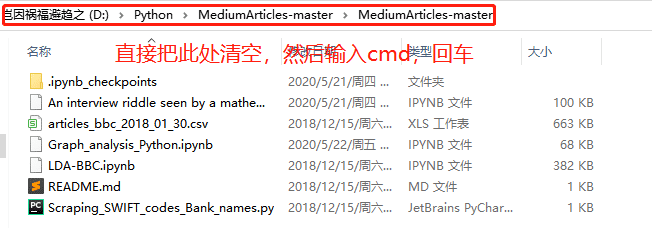Python數(shù)據(jù)正態(tài)性檢驗(yàn)實(shí)現(xiàn)過(guò)程
在做數(shù)據(jù)分析或者統(tǒng)計(jì)的時(shí)候,經(jīng)常需要進(jìn)行數(shù)據(jù)正態(tài)性的檢驗(yàn),因?yàn)楹芏嗉僭O(shè)都是基于正態(tài)分布的基礎(chǔ)之上的,例如:T檢驗(yàn)。
在Python中,主要有以下檢驗(yàn)正態(tài)性的方法:
1.scipy.stats.shapiro ——Shapiro-Wilk test,屬于專門用來(lái)做正態(tài)性檢驗(yàn)的模塊,其原假設(shè):樣本數(shù)據(jù)符合正態(tài)分布。
注:適用于小樣本。
其函數(shù)定位為:
def shapiro(x): ''' Perform the Shapiro-Wilk test for normality. The Shapiro-Wilk test tests the null hypothesis that the data was drawn from a normal distribution. Parameters ---------- x : array_like Array of sample data. Returns ------- W : float The test statistic. p-value : float The p-value for the hypothesis test.
x參數(shù)為樣本值序列,返回值中第一個(gè)為檢驗(yàn)統(tǒng)計(jì)量,第二個(gè)為P值,當(dāng)P值大于指定的顯著性水平,則接受原假設(shè)。
2.scipy.stats.kstest(K-S檢驗(yàn)):可以檢驗(yàn)多種分布,不止正態(tài)分布,其原假設(shè):數(shù)據(jù)符合正態(tài)分布。
其函數(shù)定義為:
def kstest(rvs, cdf, args=(), N=20, alternative=’two-sided’, mode=’approx’): ''' Perform the Kolmogorov-Smirnov test for goodness of fit. This performs a test of the distribution G(x) of an observed random variable against a given distribution F(x). Under the null hypothesis the two distributions are identical, G(x)=F(x). The alternative hypothesis can be either ’two-sided’ (default), ’less’ or ’greater’. The KS test is only valid for continuous distributions. Parameters ---------- rvs : str, array or callable If a string, it should be the name of a distribution in `scipy.stats`. If an array, it should be a 1-D array of observations of random variables. If a callable, it should be a function to generate random variables; it is required to have a keyword argument `size`. cdf : str or callable If a string, it should be the name of a distribution in `scipy.stats`. If `rvs` is a string then `cdf` can be False or the same as `rvs`. If a callable, that callable is used to calculate the cdf. args : tuple, sequence, optional Distribution parameters, used if `rvs` or `cdf` are strings. N : int, optional Sample size if `rvs` is string or callable. Default is 20. alternative : {’two-sided’, ’less’,’greater’}, optional Defines the alternative hypothesis (see explanation above). Default is ’two-sided’. mode : ’approx’ (default) or ’asymp’, optional Defines the distribution used for calculating the p-value. - ’approx’ : use approximation to exact distribution of test statistic - ’asymp’ : use asymptotic distribution of test statistic Returns ------- statistic : float KS test statistic, either D, D+ or D-. pvalue : float One-tailed or two-tailed p-value.
參數(shù)是:
rvs:待檢驗(yàn)數(shù)據(jù)。
cdf:檢驗(yàn)分布,例如’norm’,’expon’,’rayleigh’,’gamma’等分布,設(shè)置為’norm’時(shí)表示正態(tài)分布。
alternative:默認(rèn)為雙側(cè)檢驗(yàn),可以設(shè)置為’less’或’greater’作單側(cè)檢驗(yàn)。
model:’approx’(默認(rèn)值),表示使用檢驗(yàn)統(tǒng)計(jì)量的精確分布的近視值;’asymp’:使用檢驗(yàn)統(tǒng)計(jì)量的漸進(jìn)分布。
其返回值中第一個(gè)為統(tǒng)計(jì)量,第二個(gè)為P值。
3.scipy.stats.normaltest:正態(tài)性檢驗(yàn),其原假設(shè):樣本來(lái)自正態(tài)分布。
其函數(shù)定義為:
def normaltest(a, axis=0, nan_policy=’propagate’): ''' Test whether a sample differs from a normal distribution. This function tests the null hypothesis that a sample comes from a normal distribution. It is based on D’Agostino and Pearson’s [1]_, [2]_ test that combines skew and kurtosis to produce an omnibus test of normality. Parameters ---------- a : array_like The array containing the sample to be tested. axis : int or None, optional Axis along which to compute test. Default is 0. If None, compute over the whole array `a`. nan_policy : {’propagate’, ’raise’, ’omit’}, optional Defines how to handle when input contains nan. ’propagate’ returns nan, ’raise’ throws an error, ’omit’ performs the calculations ignoring nan values. Default is ’propagate’. Returns ------- statistic : float or array ``s^2 + k^2``, where ``s`` is the z-score returned by `skewtest` and ``k`` is the z-score returned by `kurtosistest`. pvalue : float or array A 2-sided chi squared probability for the hypothesis test.
其參數(shù):
axis=None 可以表示對(duì)整個(gè)數(shù)據(jù)做檢驗(yàn),默認(rèn)值是0。
nan_policy:當(dāng)輸入的數(shù)據(jù)中有nan時(shí),’propagate’,返回空值;’raise’ 時(shí),拋出錯(cuò)誤;’omit’ 時(shí),忽略空值。
其返回值中,第一個(gè)是統(tǒng)計(jì)量,第二個(gè)是P值。
4.scipy.stats.anderson:由 scipy.stats.kstest 改進(jìn)而來(lái),用于檢驗(yàn)樣本是否屬于某一分布(正態(tài)分布、指數(shù)分布、logistic 或者 Gumbel等分布)
其函數(shù)定義為:
def anderson(x, dist=’norm’): ''' Anderson-Darling test for data coming from a particular distribution The Anderson-Darling tests the null hypothesis that a sample is drawn from a population that follows a particular distribution. For the Anderson-Darling test, the critical values depend on which distribution is being tested against. This function works for normal, exponential, logistic, or Gumbel (Extreme Value Type I) distributions. Parameters ---------- x : array_like array of sample data dist : {’norm’,’expon’,’logistic’,’gumbel’,’gumbel_l’, gumbel_r’, ’extreme1’}, optional the type of distribution to test against. The default is ’norm’ and ’extreme1’, ’gumbel_l’ and ’gumbel’ are synonyms. Returns ------- statistic : float The Anderson-Darling test statistic critical_values : list The critical values for this distribution significance_level : list The significance levels for the corresponding critical values in percents. The function returns critical values for a differing set of significance levels depending on the distribution that is being tested against.
其參數(shù):
x和dist分別表示樣本數(shù)據(jù)和分布。
返回值有三個(gè),第一個(gè)表示統(tǒng)計(jì)值,第二個(gè)表示評(píng)價(jià)值,第三個(gè)是顯著性水平;評(píng)價(jià)值和顯著性水平對(duì)應(yīng)。
對(duì)于不同的分布,顯著性水平不一樣。
Critical values provided are for the following significance levels: normal/exponenential 15%, 10%, 5%, 2.5%, 1% logistic 25%, 10%, 5%, 2.5%, 1%, 0.5% Gumbel 25%, 10%, 5%, 2.5%, 1%
關(guān)于統(tǒng)計(jì)值與評(píng)價(jià)值的對(duì)比:當(dāng)統(tǒng)計(jì)值大于這些評(píng)價(jià)值時(shí),表示在對(duì)應(yīng)的顯著性水平下,原假設(shè)被拒絕,即不屬于某分布。
If the returned statistic is larger than these critical values then for the corresponding significance level, the null hypothesis that the data come from the chosen distribution can be rejected.
5.skewtest 和kurtosistest 檢驗(yàn):用于檢驗(yàn)樣本的skew(偏度)和kurtosis(峰度)是否與正態(tài)分布一致,因?yàn)檎龖B(tài)分布的偏度=0,峰度=3。
偏度:偏度是樣本的標(biāo)準(zhǔn)三階中心矩。

峰度:峰度是樣本的標(biāo)準(zhǔn)四階中心矩。

6. 代碼如下:
import numpy as npfrom scipy import statsa = np.random.normal(0,2,50)b = np.linspace(0, 10, 100)# Shapiro-Wilk testS,p = stats.shapiro(a)print(’the shapiro test result is:’,S,’,’,p)# kstest(K-S檢驗(yàn))K,p = stats.kstest(a, ’norm’)print(K,p)# normaltestN,p = stats.normaltest(b)print(N,p)# Anderson-Darling testA,C,p = stats.anderson(b,dist=’norm’)print(A,C,p)
以上就是本文的全部?jī)?nèi)容,希望對(duì)大家的學(xué)習(xí)有所幫助,也希望大家多多支持好吧啦網(wǎng)。
相關(guān)文章:
1. python利用os模塊編寫文件復(fù)制功能——copy()函數(shù)用法2. php測(cè)試程序運(yùn)行速度和頁(yè)面執(zhí)行速度的代碼3. php網(wǎng)絡(luò)安全中命令執(zhí)行漏洞的產(chǎn)生及本質(zhì)探究4. 三個(gè)不常見(jiàn)的 HTML5 實(shí)用新特性簡(jiǎn)介5. 無(wú)線標(biāo)記語(yǔ)言(WML)基礎(chǔ)之WMLScript 基礎(chǔ)第1/2頁(yè)6. ajax請(qǐng)求添加自定義header參數(shù)代碼7. Python使用jupyter notebook查看ipynb文件過(guò)程解析8. 解決Python 進(jìn)程池Pool中一些坑9. 解決python腳本中error: unrecognized arguments: True錯(cuò)誤10. IntelliJ IDEA創(chuàng)建普通的Java 項(xiàng)目及創(chuàng)建 Java 文件并運(yùn)行的教程

 網(wǎng)公網(wǎng)安備
網(wǎng)公網(wǎng)安備